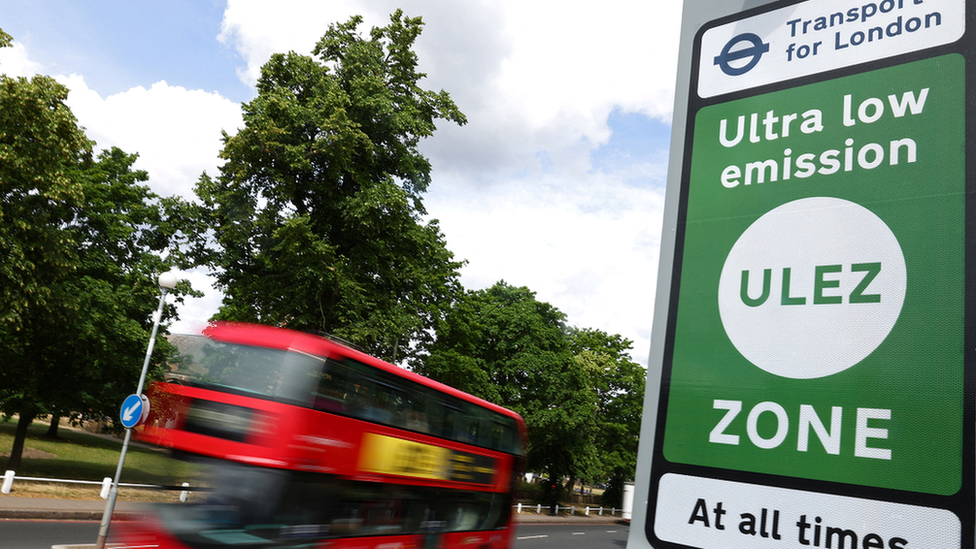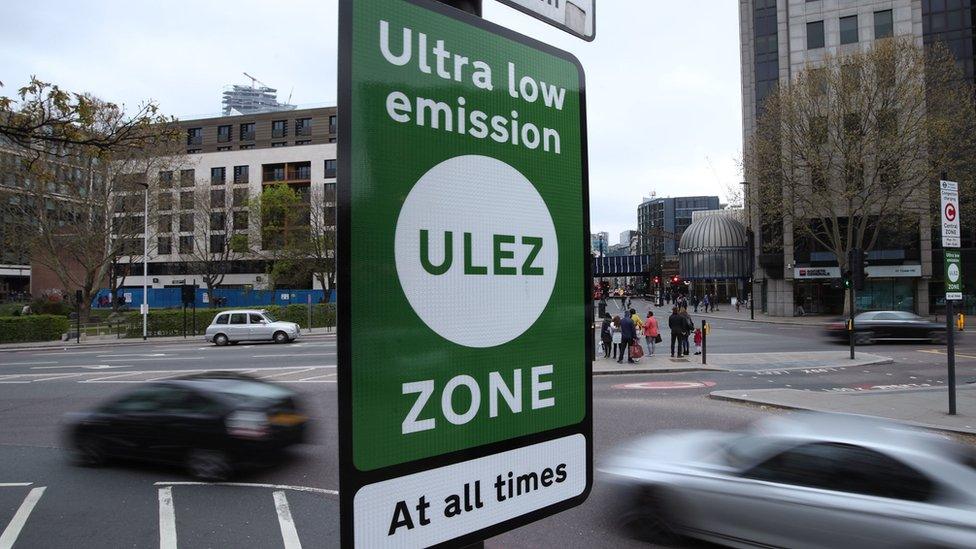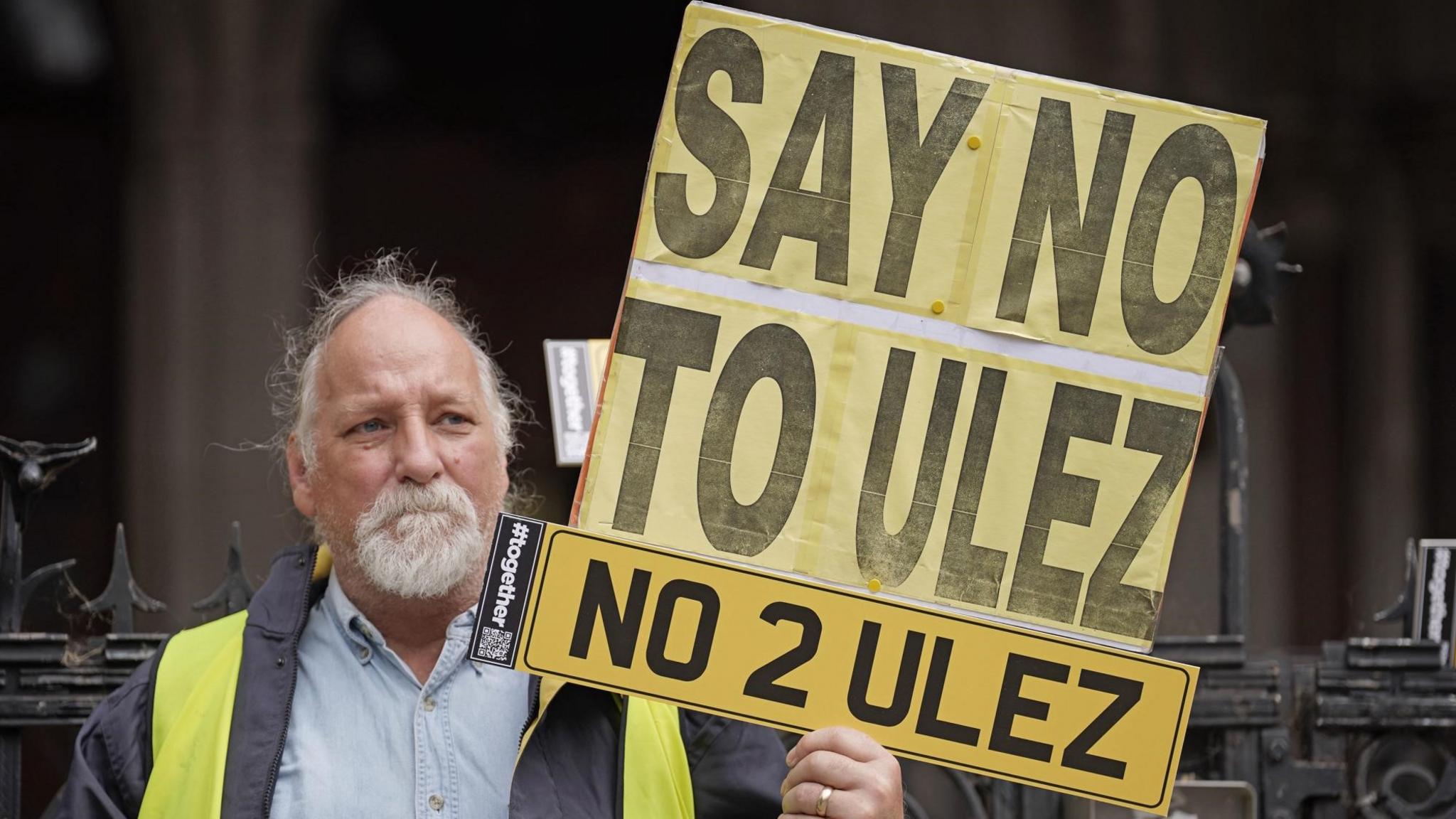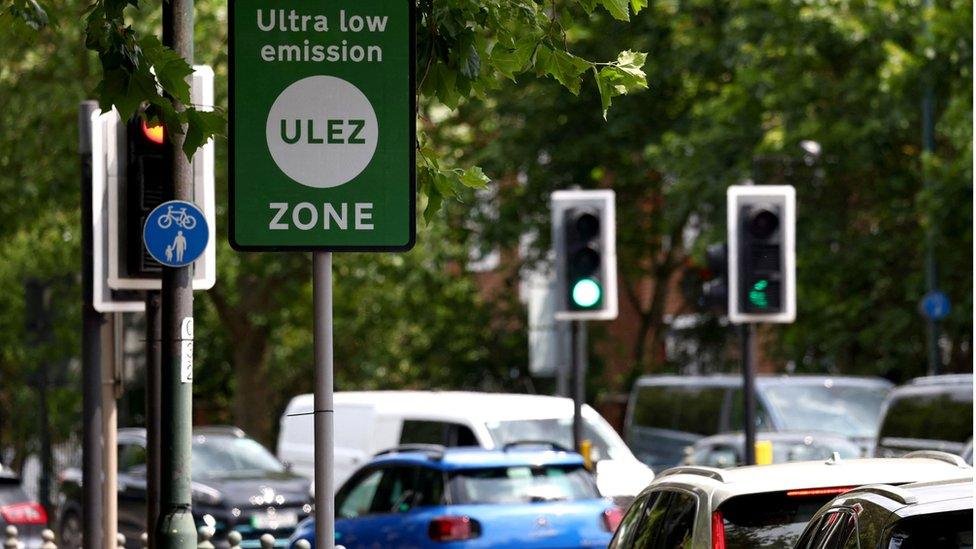What did we learn from ULEZ court action?
- Published

The mayor plans to extend the scheme from 29 August
The increasingly bitter row over expanding the Ultra Low Emission Zone (ULEZ) across Greater London reached the High Court on Tuesday and Wednesday.
It featured vast amounts of documents, data and arguments, but what new information came to light during the two-day hearing?
What did we learn?
Five Conservative councils argue that London's Labour mayor Sadiq Khan has been acting "unlawfully" in pursuing a plan to stretch the ULEZ across the whole of London.
About the only things the parties agree on is that the current zone extends to the boundaries of the north and south circular roads, and that there's a daily charge.
What were the bones of contention?
There are three areas of dispute:
One:
The councils say the mayor has gone beyond his powers and strayed outside what is lawful.
To do such an impactful thing — so considerably different in scale from what we have now — warranted a whole new "charging scheme" requiring more onerous legal and consultative hurdles to be overcome, they said.
Rubbish, said the mayor's legal team. They argued he was perfectly entitled to make a "variation" to the Low Emission Zone (LEZ) which currently exists to regulate lorries coming into London — introduced by Ken Livingstone 16 years ago.
If it was so objectionable, why wasn't it challenged when Mr Khan introduced the first two stages of ULEZ?
Two:
The councils argued people did not have a chance to make "intelligent responses" to last year's 10-week consultation process because important information was so hard to find or verify.
The judge, Mr Justice Swift, made clear he thought a key issue was whether people could easily understand or find an explanation for Transport for London's (TfL) forecast that 91% of cars would be compliant with ULEZ emission standards by the time expansion happened.
Where's the explanation for this, demanded the judge? In Appendix B, replied Ben Jaffey, barrister for the mayor.
Craig Howell Williams, acting for the councils, said you had to be a detective, poring over sentences and moving from document to document, to get anywhere. This was not easy to understand for the average member of the public, let alone council experts, he said.
Not true, said the mayor's team. More than adequate information was available if you knew where to find it. And if you could not find it, you only had to ask.
Three:
The councils claimed Sadiq Khan messed up with the scrappage scheme.
Firstly, he did not actually know what was needed so why decide on £110m? Secondly, he should have considered helping people just outside London — in a buffer zone — by letting them apply for money for scrappage too.
No way, said the mayor. That was for government to do. If you gave money to people outside London, that meant less for those inside (who actually vote for him — or not).
By the way, not all the £110m will go to hard up motorists dumping their cars. Some £7m of that goes to TfL for "administration."

Protesters against the scheme's expansion staged a protest outside the High Court
How easy was it to find key information during the consultation?
A revealing moment came on the morning of day two when the judge paused to take stock of all the relevant documents that he needed to consider, and which you might have needed to navigate to gain a half decent understanding of how ULEZ was going to affect your life.
The list included:
Main consultation document setting out the plans
Questionnaire
Integrated Impact Assessment (with appendices)
"Baseline" Integrated Impact Assessment
Mayor's Transport Strategy Integrated Impact Assessment
Data Protection Impact Assessment.
Mr Jaffey, for the mayor, said TfL was an expert at these kind of big consultations and had come up with a coherent one here.
Was it easy to find how many cars already comply?
Hmm. Here was one section in a consultation document: "Forecast compliance rates for 2023 with the proposed changes are based on work undertaken as part of on-going preparation of the LAEI (London Atmospheric Emissions Inventory) which focuses on 2019, 2025 and 2030.
"Compliance rates are based on fleet compositions which are prepared as part of the LAEI which include information on age and Euro standards, alongside fuel types and vehicle type across London.
"This information is initially derived from cross referencing anonymised ANPR camera observations in London with the DVLA record of vehicle information, alongside vehicle kilometres in London..."
Paying attention at the back?

What's the issue with the cameras?
Don't get me started. Basically, TfL insist that using data from Automatic Number Plate Recognition (ANPR) cameras is the best way to assess how many cars are not meeting ULEZ standards.
They use this method rather than what seems more logical — but gives you a lower compliance rate — which is the number of cars registered and actually owned by people in outer London.
Mr Jaffey accepted there were limitations to the method of modelling being used because there was not a big camera network in outer London.
It was revealed for the first time that the data came from only 106 cameras, those currently used for the LEZ.
They cover main, strategic roads only. Lots of cars and car journeys are not captured.
The councils did not know this until recently, nor where exactly the cameras are. If they had known, they said, they would have been able to query the compliance rates being claimed.
"If they had asked, we might have given it to them," said Mr Jaffey. But there was a good reason not to disclose locations.
"Unfortunately people have a habit of tearing them down and if they are mapped their survival times are greatly reduced," he explained.
Did the mayor attend any part of the hearing?
No, but his deputy mayor for the environment Shirley Rodrigues did, along with some senior TfL personnel.
On the first morning, the leaders — or representatives — from the five Conservative councils turned up for a photocall and unfurled a banner outside the Royal Courts of Justice.
Did any key figure emerge during the case?
Absolutely. The two days were regularly punctuated by references to the views and evidence of Christina Calderato.
She is head of transport strategy and planning at TfL, and seems to have had an overview of much of the consultation material and the scrappage plans.
She watched on, intently, as the minutiae of the case were picked over. Challenging work. She's certainly earned her annual bonus.
Strongest line?
Mr Howell Williams, for the councils, saved his most overt criticism until the end.
The mayor had embarked on "an extremely tight, unprecedented timescale and in so doing courted disaster here," he said.
What impressions did we get of what the judge thought?
Mr Justice Swift had clearly done a fair amount of reading related to the case already and has a lot more to do.
He tried to strip back sometimes complex-sounding and technical explanations so we could understand them in simpler form, and was quick to ask questions of both sides when something was not clear.
At one stage he apologised if he sounded hostile. He didn't mean to, he was just eager to find answers, he said.
A lighter moment broke through the ULEZ gloom when he was trying to establish the limits of what the mayor could do.
For example, could he vary the congestion charge so that it applied only to yellow cars?
He could not be definite, he said, but given the ULEZ expansion start date is only eight weeks away, he would do his best to get a judgement done and delivered by the legal "end of term" which is 31 July.

Follow BBC London on Facebook, external, Twitter , externaland Instagram, external. Send your story ideas to hellobbclondon@bbc.co.uk, external
Related topics
- Published4 August 2023

- Published4 July 2023

- Published5 July 2023
